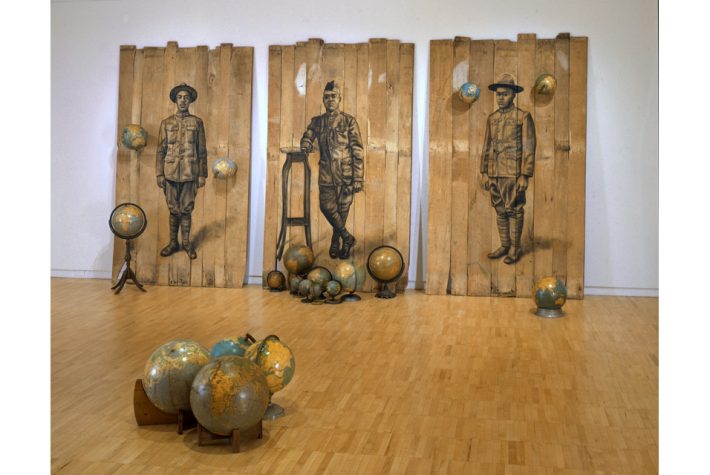via artdaily.org

Whitfield Lovell (b. 1959), Autour du Monde, 2008. Conte crayon on wood panels with globes 102 x 189 x 171 inches, Courtesy of the artist and DC Moore Gallery, New York.
CHATTANOOGA, TENN.- The Hunter Museum of American Art presents “Whitfield Lovell: Deep River,” an exhibition of work by internationally renowned artist Whitfield Lovell. The exhibition is on view through Oct. 13. Lovell, the 2007 winner of the MacArthur Fellowship (nicknamed the Genius Grant), is known for his thought-provoking images of anonymous African Americans from the 19th to early 20th centuries. The highlight of this important exhibition is “Deep River,” a large, site-specific installation that Lovell has created specifically for the Hunter Museum. Lovell’s multi-media space explores the legacy of African Americans who fled from slavery in pursuit of freedom during the Civil War. Lovell was inspired by learning of Camp Contraband, a Union encampment on the edge of the Tennessee River which became a safe haven for those who made it across. The word, ‘contraband,’ was a term used to refer to slaves, or any illegally smuggled goods. It was common for these people to assist the Union Army in various ways, including serving as cooks and valets, blacksmiths, scouts, building roads and frequently digging graves to bury the many casualties, and also eventually enlisting in the Union Army. “Deep River” incorporates drawing, sculpture, video, sound and music. The installation presents aspects of the struggles and triumphs of historical events in unexpected ways. Although the inspiration for Lovell’s narrative begins with Chattanooga’s history, his work is universal in its discussion and exploration of passage, memory and the search for freedom. The exhibition also features artwork created since 2008, including the artist’s signature “tableaux” that are constructed of intricate charcoal drawings on vintage wood juxtaposed with found objects. Lovell prefers to leave the history of his salvaged wood intact, never removing the layers of age paint, adding only his Conté crayon drawings and the objects he has collected over the years. He fully engages our senses and emotions, especially in pieces such as “Pago Pago” and “Autour du Monde.” Both works feature uniformed soldiers, referencing the service of African Americans through two world wars for a country that still didn’t acknowledge their civil or human rights and a military that was not fully integrated. Billie Holiday’s rendition of the song, “I Cover the Waterfront,” emanates from “Pago Pago,” seductively lulling the viewer into a sense of longing. Numerous globes are placed in front of “Autour du Monde” invoking both the adventure of travel and dangers of fighting abroad for soldiers. “The vintage radios that are part of several works in the exhibit remind us of the important role that radio broadcasting played in communicating both with the soldiers and with the home front,” said historian Julie L. McGee. Also included in the exhibition are a number of mixed media drawings from Lovell’s ongoing “Kin” series. Each of the “Kin” works features a portrait along with a single object. The pairing of the two creates intriguing narratives that are left open for the viewer’s interpretation. Unlike the tableaux, the images come from mug shots, photo IDs, passport images and photo booth shots that Lovell has collected. References to slavery and subjugation inevitably rise to the surface when looking at some of these pieces. However, according to Lovell, “they do not inform the creation of these works.”
